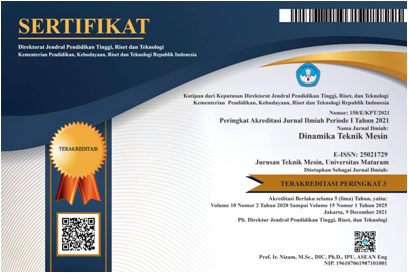Advancements in PET bottle plastic slitting devices for raw material 3D printing filament production
Abstract
Keywords
Full Text:
PDFReferences
Asroni, M., Djiwo, S., Setyawan, E.Y., Pengaruh model pisau pada mesin sampah botol plastik, Jurnal Aplikasi dan Inovasi Ipteks “Soliditas” (J-Solid), 1(1), 2018.
Bintara, R.D., Lubis, D.Z., Pradana, Y.R.A., The effect of layer height on the surface roughness in 3d printed polylactic acid (pla) using fdm 3d printing, IOP Conference Series: Materials Science and Engineering, 1034(1), 012-096, 2021.
Doe, J., Smith, A., Brown, B., Advanced pet recycling for additive manufacturing, Journal of Polymer Engineering, 45(3), 210-225, 2021.
Ji, S., P.P., Qi, Y.M., Cai, D.C., Research and application of autodesk fusion360 in industrial design, Iop conference series: Materials Science and Engineering, 359, 012-037, 2018.
Maurillia, I., 7 simbol dan jenis plastik yang perlu kamu ketahui, from https://zerowaste.id/zero-waste-for-beginners/simbol-dan-jenis-plastik/, 2025.
Nisticò, R., Polyethylene terephthalate (pet) in the packaging industry, Polymer Testing, 90, 106-707, 2020.
Novrizal, T., Sistem informasi pengelolaan sampah nasional, from https://sipsn.menlhk.go.id/sipsn/, 2025.
Pahl, G., Beitz, W., Feldhusen, J., Grote, K. H., Engineering design: a systematic approach, Springer, 1996.
Pratama, W.H., H., H., Optimasi parameter proses 3d printing terhadap kuat tarik material filament pla menggunakan metode taguchi, Sprocket Journal of Mechanical Engineering, 3(1), 39–45, 2021.
Rahman, P. I. A., Zalilah, M.N.A.T, Katiman, A.S., Design of an extrudate filament machine for recycling waste polyethylene terephthalate plastic into 3d printing filament, Journal J Innovation, 13(1), 25-32, 2024.
Smith, R., Lee, C., Thermal treatment effects on recycled pet properties, Sustainable Manufacturing Review, 12(1), 98-112, 2020.
DOI: https://doi.org/10.29303/dtm.v15i1.988
Refbacks
- There are currently no refbacks.
Copyright (c) 2025

This work is licensed under a Creative Commons Attribution-NonCommercial 4.0 International License.






















